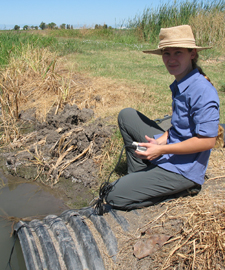Quantifying methylmercury loads from California rice fields
Summary:
Methylmercury is found in low or no oxygen environments and can be toxic to wildlife at low levels. Studies from the Yolo Bypass in the Sacramento-San Joaquin Delta suggest that rice systems may be a significant source of methylmercury in the Delta. The objectives of this study were to quantify methylmercury loads from rice fields and determine at what time of year loads are greatest. This research provided critical data on the types of methylmercury loads we can expect from rice fields and when methylmercury loads may be of concern.
Investigators:
Bruce Linquist, Principal Investigator
Assistant Cooperative Extension Specialist, Department of Plant Sciences
University of California, Davis
Collaborators:
- Lisamarie Windham-Myers, National Research Program, United States Geological Survey
- Jacob Fleck, United States Geological Survey
Project description:
Mercury in its methylated form (methylmercury) is found in anoxic environments. It is readily adsorbed, and through food chain transfer, it is toxic at low levels to animals. Field studies from the Yolo Bypass in the Sacramento-San Joaquin Delta suggest that rice systems may be a significant source of methylmercury to the Delta’s surface waters - which provide drinking water for over 20 million people and are also sensitive wildlife habitat.
Rice systems in this region comprise less than five percent of total California rice acreage and the soils and water sources used in this region are different than in the Sacramento Valley where most rice production occurs. To address this concern, a project was initiated with funding from the California Rice Research Board to investigate the methylmercury contribution of rice systems to the Sacramento River. The major findings were that rice fields are sinks for methylmercury during the growing season, but they are potentially sources during the winter. However, the winter data are problematic due to insufficient flow data required to accurately estimate loads. What is necessary, and lacking, are good loads estimates determined directly from rice fields.
This research provided critical data on the size of methylmercury loads from rice fields and when loads may be of concern. Given the cost of Hg analysis, this research helped target further research (if necessary) to critical time periods where methylmercury export may be of greatest concern.

Graduate student Christy Tanner takes rice field measurements. (Bruce Linquist)
